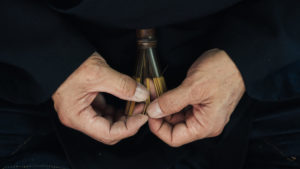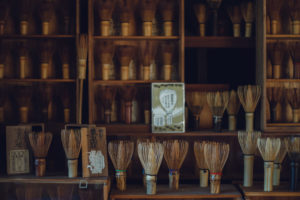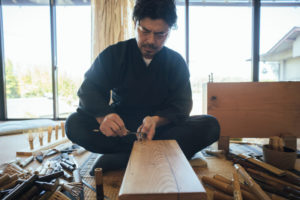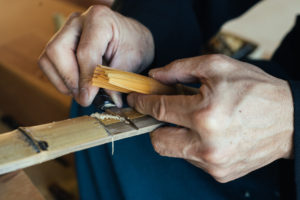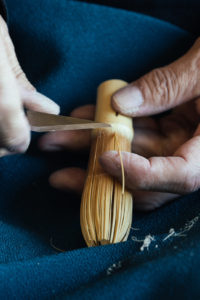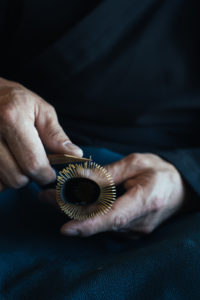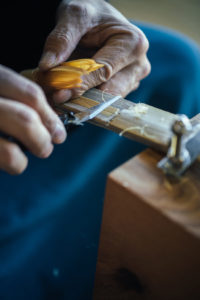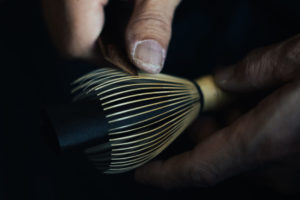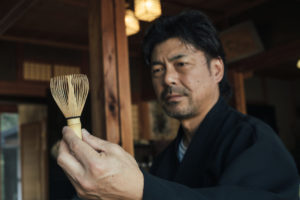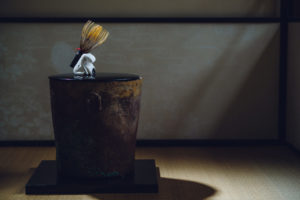I had to share this article with you because it is just so fantastic and I hope you enjoyed it as much as I have! LB
Carved from a single piece of bamboo, have you considered your Tea Whisk?
I’m a professional photographer as well as your amazing tea blogger and when this article came through my email I knew I had to share it with you.
ZEISS is a lens company and they did a photo essay on The Tea Whisk and I was lucky enough to score a copy of it.
It’s an incredible read and the pictures are awesome.
The video (link at the end of the article) is well worth the article as it shows the exactness of the carver as he makes the Whisk.
This article allowed me to have more respect for my whisk and to consider the art of it’s creation and not take for granted this piece of equipment that makes my Matcha the best it can be.
Please enjoy this article and thanks to ZEISS for providing it for us.
Hi, my name is Irwin Wong and I am professional photographer based in Tokyo, Japan. Every month on Lenspire I’ll be bringing you a journal introducing aspects of my ongoing personal project, which involves documenting traditional crafts and traditions in Japan that are in danger of going extinct. Here is entry number 11 – enjoy!
© Irwin Wong, Sony A7R ii, ZEISS Loxia 2/50 @f/2.8, 1/80 sec., ISO 400
Japanese tea whisks themselves look like works of art. Carved from a single piece of bamboo, the end is flared out into two layers of incredibly thinly rendered tines, made for mixing and frothing powdered matcha (green tea) during tea ceremonies. The tines must be cut, shaved and delicately curved according to the needs of each particular school or practitioner, and to this end, only human hands have the sensitivity to complete this task.
Master Tanimura Tango
Tanimura-san’s house sits atop a short but very steep hill in the countryside of Nara, Japan. As I lug my gear up the hill and the magnificent gate to his centuries old ancestral home comes into view I am reminded a little of a hidden monastery where great secrets are kept. I pass under the gate into one of the most beautiful Japanese houses I’ve ever seen and it’s there that I meet Tanimura Tango, the latest direct descendent in a line of tea whisk makers stretching back over five hundred years.
500 years of tradition
His ancestors also bore the name Tango – it was bestowed upon the family by the Tokugawa Shogunate to mark their status as the official supplier of tea whisks to the shogun, and the name has been handed down over the generations. These days the Tanimura family supplies two of the three most prominent schools of tea ceremony with their whisks, and they also hold workshops for those wishing to experience firsthand what it’s like to make a tea whisk.
© Irwin Wong, Sony A7R ii, ZEISS Loxia 2/50 @f/2, 1/250 sec., ISO 400
A delicate task
Japanese tea whisks themselves look like works of art. Carved from a single piece of bamboo, the end is flared out into two layers of incredibly thinly rendered tines, made for mixing and frothing powdered matcha (green tea) during tea ceremonies. The tines must be cut, shaved and delicately curved according to the needs of each particular school or practitioner, and to this end, only human hands have the sensitivity to complete this task.
© Irwin Wong, Sony A7R ii, ZEISS Loxia 2.8/21 @f/3.2, 1/125 sec., ISO 400
Few tools required
I watch as Tanimura-san begins to make a whisk. Compared to other artisans that I have photographed in the past, relatively few tools and materials are required. There are just a few different types of blades and a tiny workbench. Various types and lengths of bamboo are scattered around – Tanimura-san plucks one up seemingly at random and begins shaving the outer layer off with quick, precise movements. Then he splits the bamboo down to the middle in 8 perfectly even segments, as easily as you or I would have cut a pie. A few minutes later and a series of deft cuts render those segments into even thinner versions. This process continues until the tines are about a millimeter thick.
© Irwin Wong, Sony A7R ii, ZEISS Loxia 2/50 @f/5, 1/100 sec., ISO 400
An artisan at work
As I’m watching I’m feeling a strange disconnect between what I’m seeing and what is actually occurring – Tanimura-san works so fast and with so little hesitation that it seems for all the world that he could be chopping firewood, rather than making a delicate tea whisk. I realize that what I am witnessing before my eyes is a culmination of absolute skill and experience; muscle memory from handling tens of thousands of different bamboo pieces grown in different places in different weather conditions – the infinite variations of brittleness, roundness, thickness and unevenness must be adapted to as each tea whisk is made and this daunting task hardly slows Tanimura-san as his practiced hands gradually turn an ordinary length of bamboo into an intricate, beautiful tea whisk. I read somewhere that when performing a difficult task, skillful person will perform it well but make it look difficult, whereas a master will make it look easy. I understood the truth of that idea after watching Tanimura-san work.
© Irwin Wong, Sony A7R ii, ZEISS Loxia 2.4/85 @f/5, 1/50 sec., ISO 400
© Irwin Wong, Sony A7R ii, ZEISS Loxia 2/50 @f/4.5, 1/125 sec., ISO 400
© Irwin Wong, Sony A7R ii, ZEISS Loxia 2.4/85 @f/2.4, 1/100 sec., ISO 200
Finishing touches
After the tines are soaked the tips are then further shaved to an exacting thinness – a process called ajikezuri (literally translated as ‘flavor shaving’), because the quality of the tines – their strength, their springiness and thinness has a direct relationship to the taste of the green tea. To provide the final finishing touch, Tanimura-san curves each of the 70 to 120 tines individually using a wooden blade akin to a letter opener. The resulting tea whisk is beautifully symmetrical, more akin to a flower than the stick that it used to be.
© Irwin Wong, Sony A7R ii, ZEISS Loxia 2/50 @f/2, 1/640 sec., ISO 200
Craftsmanship achieved over half a millennia
Although looking like an ornament, Tanimura-san reminds me that at the end of the day these whisks are utilitarian tools for tea ceremony practitioners to use and discard once worn out. The basic design for whisks in Japan has not changed for hundreds of years – as a tool it was perfected years ago. Tanimura-san tells me his job now is to maintain the high level of craftsmanship his family has achieved over half a millennia, and if possible further improve the usability and durability of his products.
© Irwin Wong, Sony A7R ii, ZEISS Loxia 2/50 @f/6.3, 1/60 sec., ISO 250
A moment of serenity
The next day I find myself at the house of Amae Dairik, a young tea ceremony master. A typhoon is passing overhead and heavy drops of rain are drumming on the glass windows of his tea room. With one of Tanimura-san’s whisks, he shows me how to make matcha. His motions are serene and glacial, a stark contrast to the storm outside. The finished tea is served, and for a while I am able to take a break, forget about work, sip tea and watch the rain batter the windows. A perfect moment of serenity in the midst of the tempest. I think of Tanimura-san’s ancestors over the course of centuries, perfecting the art of making tea whisks, and I can’t help but think that this moment is what it’s all been leading up to.
© Irwin Wong, Sony A7R ii, ZEISS Loxia 2.4/85 @f/4, 1/60 sec., ISO 400

